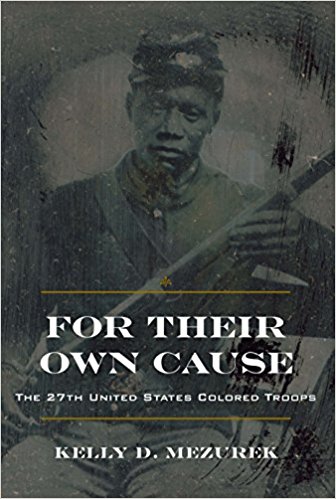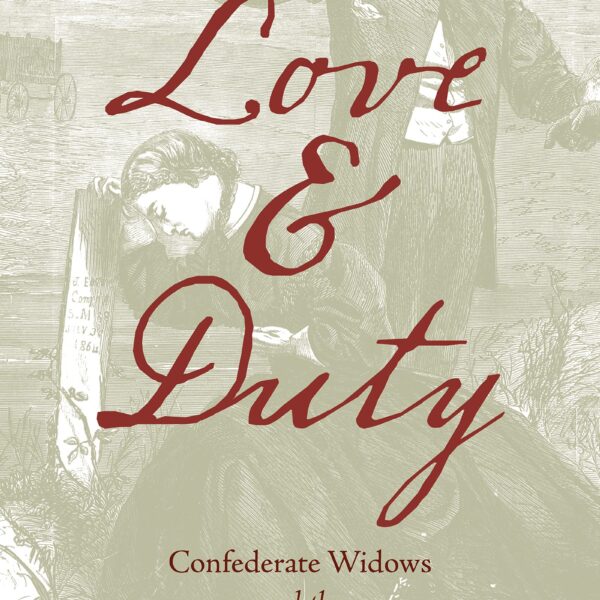For Their Own Cause: The 27th United States Colored Troops by Kelly D. Mezurek. The Kent State University Press, 2016. Cloth, IBSN: 978-1606352892. $37.95.
 Kelly D. Mezurek’s study of the 27th United States Colored Troops is an insightful examination of the influence of the Civil War on one African American regiment—and, through a discussion of the experiences of these returning Union veterans in Northern society, the entire free black Northern population. Directing the reader away from a monolithic interpretation of the USCT, which, admittedly, often prioritizes the service of the freedmen or highlights the exceptional history of Robert Gould Shaw and the 54th Massachusetts, For Their Own Cause stresses that the history of the 27th USCT “provides the opportunity to explore a more representative example of Northern black participation, one in which there was a preponderance of fatigue duty but limited battle experience and even less recognition” (5). Through their participation in the Civil War, and their efforts to maintain the hard-earned rights of citizenship in its aftermath, Mezurek concludes that these African American veterans contributed to an astonishing redefinition of their own political status, while helping to expand the rights of all African Americans (2).
Kelly D. Mezurek’s study of the 27th United States Colored Troops is an insightful examination of the influence of the Civil War on one African American regiment—and, through a discussion of the experiences of these returning Union veterans in Northern society, the entire free black Northern population. Directing the reader away from a monolithic interpretation of the USCT, which, admittedly, often prioritizes the service of the freedmen or highlights the exceptional history of Robert Gould Shaw and the 54th Massachusetts, For Their Own Cause stresses that the history of the 27th USCT “provides the opportunity to explore a more representative example of Northern black participation, one in which there was a preponderance of fatigue duty but limited battle experience and even less recognition” (5). Through their participation in the Civil War, and their efforts to maintain the hard-earned rights of citizenship in its aftermath, Mezurek concludes that these African American veterans contributed to an astonishing redefinition of their own political status, while helping to expand the rights of all African Americans (2).
The greatest strength of Mezurek’s work is the attention given to the varied backgrounds, motivations, wartime service, and postwar experiences of the individual men who comprised the 27th USCT. For Their Own Cause eschews easy generalizations in favor of painstaking detail, and the results are impressive. This is a carefully measured regimental history that delves into nearly every aspect of life in Union blue—from whether an individual volunteered or was drafted, to the nature of their military commitment, through to the efforts of veterans and their beneficiaries to collect pensions from the United States government. More than anything else, Mezurek reminds the reader that the USCT presented African Americans with an opportunity that different individuals capitalized on in an assortment of ways.
For instance, when discussing the reasons that soldiers enlisted in the 27th USCT, For Their Own Cause highlights a range of motivations: the opportunity to end slavery; the opportunity to free themselves or family members; a sense of religious duty; obligations as men and to the Union; a desire for adventure and camaraderie; economic opportunities; and the force of the draft (55). At times, strict dedication to the “multiple and varied experiences” (6) of the men in the 27th USCT tends toward overly qualified paragraphs and sections that are slightly confusing, but this is a minor quibble that all historians who grapple with the messiness of lived reality must confront.
For Their Own Cause is organized both chronologically and topically, and Mezurek ably blends the wartime service of the 27th USCT into a wider discussion of the changing position of African Americans in Ohio throughout the nineteenth century. Although black Ohioans were free on the eve of the Civil War, Mezurek notes that white residents of the state largely viewed African Americans as inferior and deemed them unfit to fight for the Union. When sagging white enlistments and hostility to the draft finally forced Ohio to accept black volunteers, the martial experience opened the door for blacks to demand equality (40). The bulk of For Their Own Cause is dedicated to the daily grind that confronted these men throughout their military careers, from April 1864 to September 1865, but the final chapter is an intriguing discussion of the changing society that the veterans of the 27th USCT returned to after the final shots of the war had been fired. As Mezurek contends, black soldiers and their families were more successful at staking their claims to citizenship than other members of the African American community, but even then the results were varied. While many members of the 27th USCT garnered respect in their communities and were able to collect pensions for decades, others were not so fortunate. By the end of nineteenth century, Mezurek argues that the reconciliationist interpretation of the Civil War eroded the status of black veterans and slowly erased their place in the national consciousness.
Ultimately, For Their Own Cause is a well-written, engaging treatment of the 27th USCT that does far more than most regimental histories. While the military careers of these particular men in blue is given ample coverage, Mezurek is far more concerned with the way in which black regiments such as the 27th USCT influenced Ohio society in the postbellum decades. The “significance” of African American service in the Civil War, Mezurek concludes, was not the wartime experience, but the utilization of that service to demand the benefits of citizenship (12). It would be a slow and uneven journey to secure these rights.
Jacob A. Glover is a Ph.D. Candidate at the University of Kentucky. His dissertation examines everyday racial violence and the formation of black citizenship in the postbellum South.




